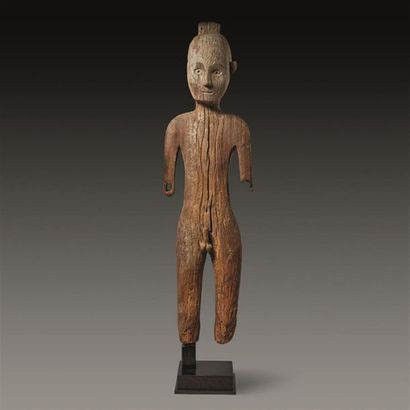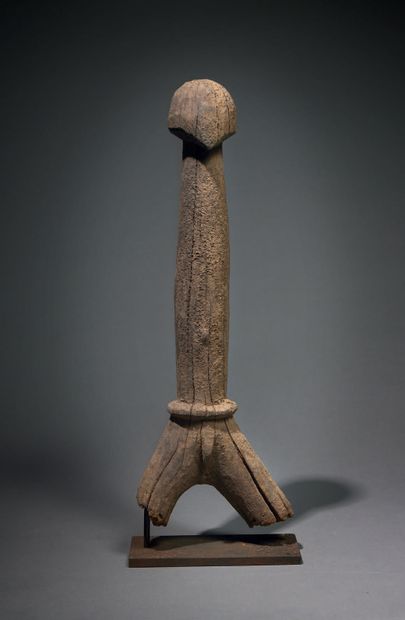Ɵ Effigie d'ancêtre masculin, Jukun, Est du Nigeria, style de Wurbo Époque: XIXe siècle ou antérieur Bois partiellement érodé à épaisse patine sacrificielle, polychromie H. 64,8 cm Male ancestor effigy, Jukun, East Nigeria, Wurbo style H. 25.2 in Provenance: - Collection Ginzberg, New York - Collection privée Publication: - Marla Berns, Central Nigeria Unmasked: Arts of the Benue River Valley, UCLA Fowler Museum of Art, 2011, p.288, n°E.7 - Marc Ginzberg, The African Art Collection of Marc and Denyse Ginzberg, New York, Private Edition (10 copies), 2003, n°37 Exposition: - Fowler Museum at UCLA, février-juillet 2011 - NMAA Smithsonian Institution, septembre 2011-février 2012 - Cantor Arts Center, Stanford University, mai-septembre 2012 - Central Nigeria Unmasked: Arts of the Benue River Valley, Fowler Museum at UCLA, février-juillet 2011 - National Museum of African Art, Smithsonian Institution, Washington D.C., septembre-février 2012 - Cantor Arts Center at Stanford University, 15 avr.-9 sept. 2012 - Musée du quai Branly, novembre 2012-janvier 2013 Les populations Jukun ont une histoire très ancienne imprégnée par les incessantes guerres qu'ils firent à leurs voisins. Leur culture est archaïque et leur statuaire a influencé stylistiquement les productions artistiques des populations contiguës, Wurkun, Mumuye et Chamba. D'importantes et rares effigies d'ancêtre sont le fleuron du patrimoine Jukun. Erigées sur les autels des familles de notables elles témoignaient du respect dû aux grands ancêtres et parfois aux couples fondateurs de lignée. Un culte leur était rendu afin d'accorder au groupe fécondité familiale et fertilité des sols. Depuis l'ombilic, la partie basse de l'œuvre montre un bois dur délavé et érodé tandis que le torse et la tête sont recouverts d'une patine noire épaisse, rehaussée de motifs linéaires blancs et rouges. L'usure et les aspersions rituelles répétées ont rendu son visage presqu'abstrait mais conservant sa dignité et son mystère. Il est encadré par des oreilles aux lobes distendus par d'importants pendants tubulaires, surmonté d'un étroit bonnet à décor géométrique et prolongé au menton par une barbe à trois tresses. L'étrange inclinaison du cou est une constante stylistique de la région. D'après les travaux d'Arnold Rubin, il est probable que cette œuvre importante provienne du village de Mabo, centre stylistique Jukun des plus importants. Les productions sculpturales de Mabo et d'autres villages proches, comme Gaji et Wurbon Daudu, définissent le style dit de Wabo dont une vingtaine d'exemplaires seulement sont parvenus jusqu'à nous. Effigy of male ancestor Jukun people, eastern Nigeria, Wurbo style 19th century or earlier Partially eroded wood with a thick sacrificial patina, polychrome H. 25.2 in Provenance: - Ginzberg's collection, New York - Private collection Publication: - Berns, Fardon, Kasfir, 2011 Exhibition: - Fowler Museum at UCLA, February - July 2011 - NMAA Smithsonian Institution, September 2011 - February 2012 - Cantor Arts Center, Stanford University, May - September 2012 The Jukun populations have a very ancient history marked by continual warfare waged on their neighbours. Their culture is archaic, and their statues had a stylistic influence on the art of the nearby populations, the Wurkun, Mumuye and Chamba. Important and rare effigies of ancestors are the hallmarks of Jukun culture. They stood on the altars of notable families, showing the respect due to great ancestors and sometimes to the couples who had founded the family line. The statues were worshipped so that they would grant fertility to the family group and to the soil. From the navel downwards, the work is done on a hard, faded and eroded wood, while the torso and head are covered with a thick, black patina, decorated with white and red linear patterns. Repeated handling and ritual aspersions have given the face an almost abstract appearance, but it has maintained all its dignity and mystery. The face is framed by ears
Ɵ Effigie d'ancêtre masculin, Jukun, Est du Nigeria, style de Wurbo Époque: XIXe siècle ou antérieur Bois partiellement érodé à épaisse patine sacrificielle, polychromie H. 64,8 cm Male ancestor effigy, Jukun, East Nigeria, Wurbo style H. 25.2 in Provenance: - Collection Ginzberg, New York - Collection privée Publication: - Marla Berns, Central Nigeria Unmasked: Arts of the Benue River Valley, UCLA Fowler Museum of Art, 2011, p.288, n°E.7 - Marc Ginzberg, The African Art Collection of Marc and Denyse Ginzberg, New York, Private Edition (10 copies), 2003, n°37 Exposition: - Fowler Museum at UCLA, février-juillet 2011 - NMAA Smithsonian Institution, septembre 2011-février 2012 - Cantor Arts Center, Stanford University, mai-septembre 2012 - Central Nigeria Unmasked: Arts of the Benue River Valley, Fowler Museum at UCLA, février-juillet 2011 - National Museum of African Art, Smithsonian Institution, Washington D.C., septembre-février 2012 - Cantor Arts Center at Stanford University, 15 avr.-9 sept. 2012 - Musée du quai Branly, novembre 2012-janvier 2013 Les populations Jukun ont une histoire très ancienne imprégnée par les incessantes guerres qu'ils firent à leurs voisins. Leur culture est archaïque et leur statuaire a influencé stylistiquement les productions artistiques des populations contiguës, Wurkun, Mumuye et Chamba. D'importantes et rares effigies d'ancêtre sont le fleuron du patrimoine Jukun. Erigées sur les autels des familles de notables elles témoignaient du respect dû aux grands ancêtres et parfois aux couples fondateurs de lignée. Un culte leur était rendu afin d'accorder au groupe fécondité familiale et fertilité des sols. Depuis l'ombilic, la partie basse de l'œuvre montre un bois dur délavé et érodé tandis que le torse et la tête sont recouverts d'une patine noire épaisse, rehaussée de motifs linéaires blancs et rouges. L'usure et les aspersions rituelles répétées ont rendu son visage presqu'abstrait mais conservant sa dignité et son mystère. Il est encadré par des oreilles aux lobes distendus par d'importants pendants tubulaires, surmonté d'un étroit bonnet à décor géométrique et prolongé au menton par une barbe à trois tresses. L'étrange inclinaison du cou est une constante stylistique de la région. D'après les travaux d'Arnold Rubin, il est probable que cette œuvre importante provienne du village de Mabo, centre stylistique Jukun des plus importants. Les productions sculpturales de Mabo et d'autres villages proches, comme Gaji et Wurbon Daudu, définissent le style dit de Wabo dont une vingtaine d'exemplaires seulement sont parvenus jusqu'à nous. Effigy of male ancestor Jukun people, eastern Nigeria, Wurbo style 19th century or earlier Partially eroded wood with a thick sacrificial patina, polychrome H. 25.2 in Provenance: - Ginzberg's collection, New York - Private collection Publication: - Berns, Fardon, Kasfir, 2011 Exhibition: - Fowler Museum at UCLA, February - July 2011 - NMAA Smithsonian Institution, September 2011 - February 2012 - Cantor Arts Center, Stanford University, May - September 2012 The Jukun populations have a very ancient history marked by continual warfare waged on their neighbours. Their culture is archaic, and their statues had a stylistic influence on the art of the nearby populations, the Wurkun, Mumuye and Chamba. Important and rare effigies of ancestors are the hallmarks of Jukun culture. They stood on the altars of notable families, showing the respect due to great ancestors and sometimes to the couples who had founded the family line. The statues were worshipped so that they would grant fertility to the family group and to the soil. From the navel downwards, the work is done on a hard, faded and eroded wood, while the torso and head are covered with a thick, black patina, decorated with white and red linear patterns. Repeated handling and ritual aspersions have given the face an almost abstract appearance, but it has maintained all its dignity and mystery. The face is framed by ears















Testen Sie LotSearch und seine Premium-Features 7 Tage - ohne Kosten!
Lassen Sie sich automatisch über neue Objekte in kommenden Auktionen benachrichtigen.
Suchauftrag anlegen